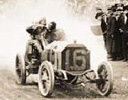Book Review
by Russell Jaslow
Blood and Smoke
by Charles Leerhsen
Simon & Schuster
ISBN: 978-1-4391-4904-1. List Price: $26.00.
  There is one word to summarize this book -- disappointing. There is one word to summarize this book -- disappointing.
Charles Leerhsen set out with the goal to once and for all settle the debate over who won the inaugural Indianapolis 500 of 1911. Instead, he spends 251 pages showing everyone how superior of a writer he can be, belittling prior researchers attempts to find the answer, blaming seemingly every death that occurred in Indianapolis on racing, praising the scoundrels in the sport while wishing harm on the good guys, and displaying his New York City stick and ball sports writer hatred towards auto racing.
Leerhsen, a former editor of Sports Illustrated as well as a writer for Esquire, Rolling Stone, The New York Times Magazine, and other top flight magazines, can certainly wordsmith with the best of them. That style will get you through some of the diatribe he fills the pages with. However, instead of using that style to pull in uninterested readers to such a fascinating subject, he uses it to simply show off.
With the backing of a powerful publisher, Simon & Schuster, and professional researchers at his disposal, he had the means to do more with this subject than anyone before, including this book reviewer. Even if he couldn't find the Holy Grail of evidence, he still had the ability, if he wanted to be a proper historian, to present theories and possibilities (which he does to a limited degree), and compare them to previous theories and possibilities. Instead, he seems more content to making sure he points out the flaws of previous research, by calling them "... a couple of rather sloppily executed magazine pieces." The only time he does provide details of those efforts is to point out the admittedly incorrect portions of those articles. He even allows Donald Davidson, the official historian of the Indianapolis Motor Speedway, one opportunity to be heard, and that was to provide him a forum to disparage a previous article as a simple ax to grind effort during the CART-IRL wars, without ever asking the true intentions and interest of the author.
The classic stick and ball sports writer loves to point out the death that to them permeates auto racing. Leerhsen takes it one step further. You can barely go more than a few pages without Leerhsen somehow relating death to the Speedway, even going as far as linking almost every traffic accident fatality to the sport. Does he also go on and on about every drunk driving fatality of fans leaving a game, and decide that football, baseball, hockey, and basketball are by association blood sports? Racing was very, very dangerous during that time (as was football). No doubt about it. But, a lot of people, most of them in fact, survived the sport. You would never know it when you're done with this book. He even gives the impression the Coroner depended on the sport to make a living...
Leerhsen wants to convey a sense of chaos that existed in the sport, the Speedway, Carl Fisher, and everyone associated with cars. However, like any group of people during any time period, you had your scoundrels and saints, your philanderers and family men, your cussers and choirboys. But, the author is not interested in the uplifting stories, even going so far as to show his disdain for the good guys in racing by stating, "DePalma was one of the bravest and most beloved drivers of the early times, but when he talked like this, you sometimes wished he would blow a tire and crash -- ideally into Joe Dawson, his fellow Goody Two-shoes." Apparently, there wasn't enough death in the book to please the author.
If you're a racing fan, you will very quickly realize Leerhsen has no understanding of the sport or the people involved. Nor does he care to. He stumbled upon a subject that seemed fascinating to him, and hoped to be a hero in solving a great sports mystery. When he couldn't, his views of the sport came out, even going as far to use Jim Murray's infamous line, "Gentlemen, start your coffins," obviously having no idea Murray was actually a big racing fan and his true motivation for writing that line.
He does present a wonderful essay near the end of the book about how creation mythology is a necessity for people. We have them in the creation of America -- George Washington and the apple tree, Betsy Ross and the flag, etc. The Indy 500 has it's creation mythology in local hero with colorful unique car winning the first Indy 500.
However, the few bright spots in the book pale to an endeavor which skidded so out of control. No matter which side of the debate you are on, you will find yourself rooting against the whole effort. This could have been a proper historically researched, well written treatise on the first Indy 500. Sadly, it is anything but.
Disappointing.
Copyright © 2011 by . All Rights Reserved.
|



